NUCLEAR TERROR How Russia took the nuclear plant and the people of Enerhodar hostage
"We are safe, we have a nuclear power plant, they wonʼt come here, they won't shoot here, they won’t mess with such things", thought the residents of Enerhodar. But they were wrong. We traced what happened at the ZNPP (Zaporizhzhia Nuclear Power Plant) and in Enerhodar since the capture of the city.
NUCLEAR TERROR
How Russia took the nuclear plant and the people of Enerhodar hostage
Capture of the city
Intimidation of the power plant’s personnel and safety threats
Resistance of Enerhodar residents
Shelling of Enerhodar
The mission of the IAEA
Occupation and change of infospace
"We are safe, we have a nuclear power plant, they won't come here, they won't shoot here, they won’t mess with such things", thought the residents of Enerhodar. But they were wrong. We traced what happened at the ZNPP (Zaporizhzhia Nuclear Power Plant) and in Enerhodar since the capture of the city.
Joint project. Zaporizhzhia Center of Investigation: data collection, text.Texty.org.ua: visualization, storytelling and data collection consultations.
Translated by Dmitry Lytov
Capture of Enerhodar
Enerhodar is connected to Zaporizhzhia by a single asphalted road along the Kakhovka Reservoir to Vasylivka, where it connects with the Kharkiv-Simferopol highway. When the Russians captured Melitopol, they had 60 km to march to Vasylivka. As soon as they occupied it, Enerhodar was doomed. Another group of Russian troops was moving from the Kherson direction.
Workers of the military commissariats and the police left Enerhodar on February 25 – luckily, they took the documents. Only a few dozen National Guardsmen, who guarded the ZNPP and patrolled the city, remained in the city. Weapon supplies for the local Teroborona (Territorial Defense) were supposed to arrive from Zaporizhzhia by the same single road from Vasylivka, but it did not happen timely. Part of the Teroborona soldiers went to meet the transport with weapons, received them and gave the occupiers a fight already in Vasylivka. Then they defended Zaporizhzhia.
On the morning of February 26, the Russians captured the village of Velyka Bilozerka, 30 km south of Enerhodar.
Local residents decided to defend Enerhodar even without weapons: they erected a roadblock at the entrance to the city. For three days, about 10,000 residents of the city, according to the mayor of Enerhodar Dmytro Orlov, have been going to the checkpoint to stop the Russian army with peaceful protests. These were almost all adults who stayed in the city and did not go to work (most of them were either directly employed at the nuclear power plant or the thermal power plant, or worked in their maintenance services).

Enerhodar residents went to the road leading to the city to stop the Russian troops.
Photo by Dmytro Orlov
On March 3, the Russians finally opened fire on protesters and entered the city, shelling civilian buildings in the center of Enerhodar along the way.
In the evening, they went to the ZNPP.
Zaporizhzhia NPP is the largest nuclear power plant in Ukraine that has a capacity of 6 gigawatts, making up 45% of the Ukrainian nuclear energy capacity and over 20% of Ukraine’s energy system capacity. Enerhodar – a city where staff operating ZNPP live – was built between 1970 and 1980 along with thermal and nuclear power plants. At the time of the full-scale invasion, about 50,000 residents lived in Enerhodar, including around 11,000 staff working at both the ZNPP and the infrastructure facilities serving the station. After the Russian occupation, according to Energoatom (Ukraine’s state nuclear agency), there were 3,000 staff at the station. 1,400 employees go to work daily.
The map showing the capture of Enerhodar and the ZNPP

The scariest night ever
On the night of March 4, 2022, the whole world watched the online broadcast from a surveillance camera located on one of the buildings of the ZNPP. A fire was burning in the darkness. No one understood what was happening and whether a new Chernobyl would happen.
A siren wailed over Enerhodar all night. "We’ve been told that these sirens simply burned out by six o'clock in the morning," says Olha, a local resident. This eerie sound and fear were even scarier because of uncertainty. Enerhodar residents watched the flames over the station, knew that firefighters were not allowed there, and were concerned about radiation and exposure. There were no bomb shelters or other protective structures in the city. In case of an accident at the station in peacetime, evacuation buses would be provided.
Of the military forces in the city, only a National Guard unit was guarding the ZNPP and patrolling the city. The soldiers had small arms, grenade launchers and, "apparently, one ‘Cossack’ armored car," recalls Ivan Petukhov, head of the electric network department of the ZNPP.
Our military tried to fight.
"The Russians simply razed to dust the educational and training center from where the National Guardsmen were shooting. Then they hit the main building with large-caliber shells... They were just showing their strength," Petukhov continued.

The ZNPP training center after the night battle for the nuclear plant.
Photo: Energoatom
According to the testimony of one of the local activists, during the storming of the ZNPP, three soldiers of the National Guard from its security detachment were killed and another five or six were wounded. 30-40 people were captured by the Special Rapid Response Unit from Ingushetia — they were the ones who attacked the station. Locals say that the prisoners were taken to a field nearby and stripped down to their underwear; the capturers shot over their heads, made the prisoners sign a pledge not to fight again and released them to Enerhodar. Some of the captives managed to get to Ukraine-controlled areas, while others were recaptured and taken to Crimea later on – already from Enerhodar.
The occupiers also captured the National Guard’s regular soldiers who were patrolling the city, and first used them for public works, but then took them to Crimea. They were returned during the November 22 exchange.
That night, the second, third and fourth floors of the training center near the ZNPP burned down. Firefighters were allowed to put out the fire only a few hours later, at 6 a.m. on March 4.
This battle marked the inception of nuclear blackmail carried out by Russia. The territory of the ZNPP was turned into a garrison, where about 500 Russian soldiers along with heavy equipment and ammunition are being stationed. From the station, the Russians are shelling free Ukrainian territories. 3,000 station workers and about 20,000 residents of Enerhodar, which the Russians are shelling for provocations, became hostages of the Russian army.
For example, on July 12, the Institute for the Study of War (ISW) reported on one of the Russian attacks under a foreign flag, which Russia blamed on the Armed Forces of Ukraine.
Russians terrorize the station's Ukrainian staff: they force them to sign contracts with Rosatom (the Russian Nuclear Power Agency), kidnap, torture, and kill them. The greatest danger today is the regular disconnection of the ZNPP from the Ukrainian power grid after Russian shelling of power lines. Diesel generators then become the last safeguards against a nuclear disaster.
"Enerhodar is Ukraine!"
Throughout March 2022, thousands of Enerhodar residents regularly took to the streets of the already occupied city for rallies under Ukrainian flags. Mass demonstrations took place on March 9, the birthday of Taras Shevchenko (a renowned Ukrainian poet), on March 20 and 28, as well as on April 2, in support of Ukraine and as a sign of protest against the kidnapping of the city's deputy mayor, Ivan Samoydiuk.

Rally in Enerhodar on March 20.
Photo: Dmytro Orlov
On April 2, Rosgvardiya (the Russian Federal Guard) soldiers began to grab and drag the protesters to their cars and fire mortars at the gathering.
After the establishment of the occupying authorities, the Russian special services assisted by local collaborators searched for and abducted the participants of the demonstrations.
Events at the ZNPP
On March 4, 2022, only power unit # 4. was in working order at ZNPP. Power unit # 1 was undergoing preventive maintenance. Power units # 2 and # 3 were disconnected from the network and switched to a safe mode. Power units # 5 and # 6 were also transferred to a safe mode.
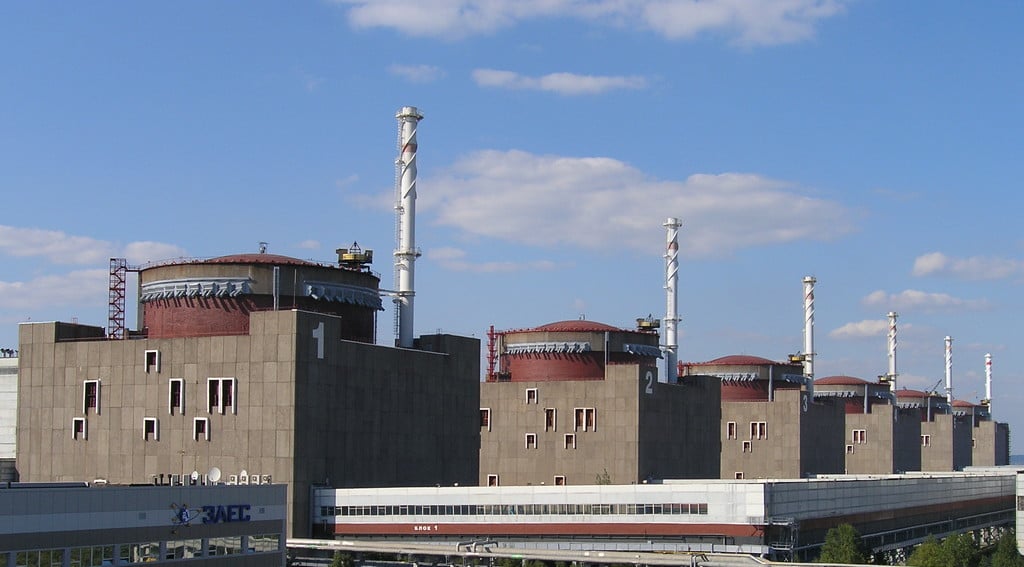
It is the power units # 5 and # 6 that were regularly disconnected from the power grid due to Russian shelling of power lines, and only automatic activation of diesel generators prevented them from causing a nuclear disaster. During the occupation, the power plant was completely shut down three times: on August 25, October 2, and November 2. At the end of 2022, all six reactors of the Zaporizhzhia NPP were shut down, but they still consume electricity from the Ukrainian power system. The Russians are blocking their connection.
At midnight, a live broadcas of the Russian army capturing the station began from a surveillance camera located in the administration building on the territory of the ZNPP. The camera worked for several hours until the Russians got hold of the station.
A Russian projectile hit power unit # 1 and damaged the reactor cladding. Two shells hit near a spent nuclear fuel storage facility, Energoatom reported.
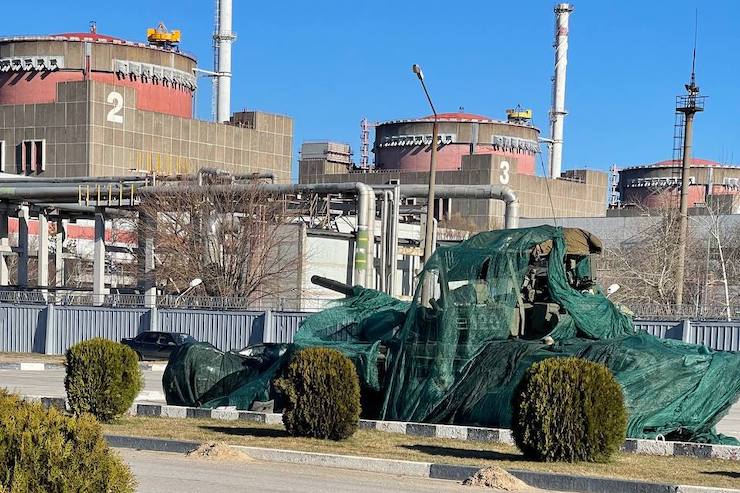
On March 15, Petro Kotin, head of Energoatom Agency, stated that there are about 400 Russian military personnel, 50 pieces of equipment and a lot of explosives and weapons located on the territory of the ZNPP.
Satellite images (from the Planet website) taken in June 2022 show that the Russian military has built fortifications around the ZNPP. The same was announced by the mayor of Enerhodar on June 24. Further pictures show the active use and growth of fortifications: in the industrial zone along the road from Enerhodar to the ZNPP, on the reservoir bank near the station, and near the fire station.
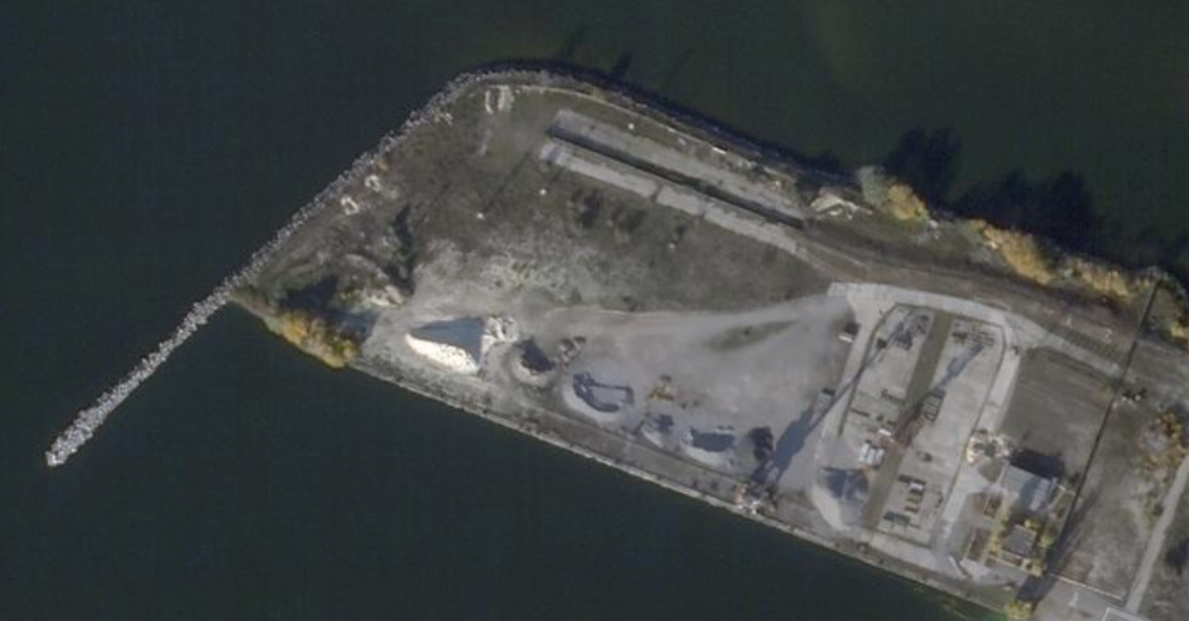
On June 29, the Russian military tortured to death Andriy Honcharuk, a diver of the hydroelectric plant of the ZNPP. He was forced to dive into the cooling pool of the ZNPP. He was required to drain the cooling pool ostensibly to check its bowls for the presence of previously planted weapons, but it was a provocation fabricated by the Russians.
The military ordered the ZNPP administration to open the engine rooms at power units # 1, # 2, and # 3 in order to place their military equipment inside. At least 14 units of heavy military equipment with ammunition, weapons and explosives have been placed in the engine room of power unit #1, as reported by Energoatom. Later, the information about the location of the military and ammunition in the machine rooms of the plant was confirmed by Insider sources at the ZNPP and the interlocutor of the BBC – an engineer who worked there during the occupation.
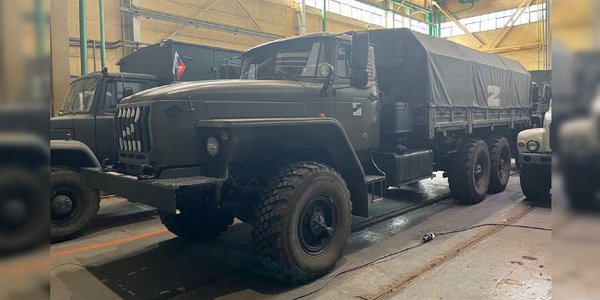
On July 22, a Ukrainian kamikaze drone attacked a Russian military tent city and equipment located opposite power unit #1. It hit three anti-aircraft guns and a Grad BM-21. Three soldiers were killed, 12 were injured.
On August 5, The Insider released a video
with evidence of the movement of military equipment near the reactors.
Also, the investigators, with reference to sources, reported on the mining of the engine room at the power unit #1 and the area around the ZNPP; on the placement of Grad mobile artillery units near the village of Vodiane; on ammunition stored near power units, inside and under overpasses.
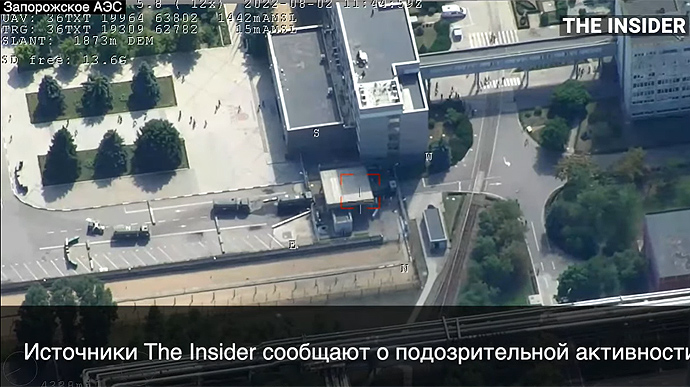
One of the station’s engineers mentioned in an anonymous BBC interview about the overpasses, under which the Russians stored military equipment. "For example, under the overpass nea Special Building # 2 they place Grad mobile artillery units with ammunition on occasions," he said. He also stated that he saw Russian artillery installations at the site generally used for storage of heavy metal structures, such as steam generators prepared for replacement of the old ones.
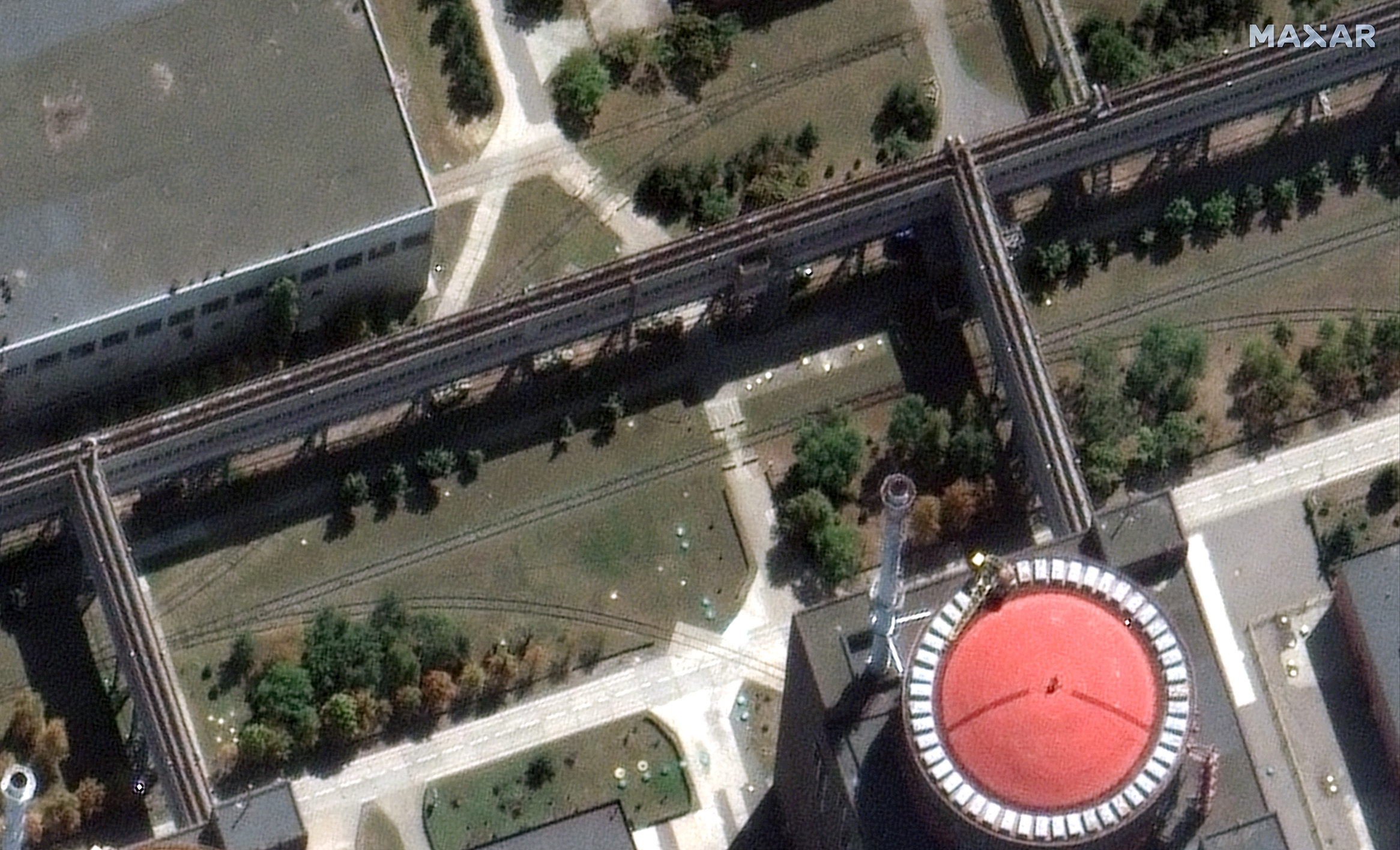
On August 5, shelling of the ZNPP began, aimed at destroying the energy infrastructure connecting the plant to the Ukrainian power grid. At 2:30 p.m., a 330 kV high-voltage communication line of the ZNPP autotransformer hit the high-voltage communication line, Zaporizhzhia thermal power plant (TPP) reported.
On August 6, Energoatom reported the impact of Russian munitions on the ZNPP site near the dry storage of spent nuclear fuel(SFU), the leakage of which could cause an environmental disaster. The repository stores 174 containers of 24 assemblies of spent nuclear fuel. Due to shelling, the radiation monitoring sensors, which are supposed to notify about radiation leakage, were damaged.
Bombardment of the ZNPP: Energoatom reports five "arrivals" in the area of the station's command post — not far from the welding area and the storage of radiation sources. The pumping station of household sewage was damaged.
On August 22, the Russians additionally brought two armored personnel carriers and six special trucks to the station's repair zone, Energoatom reports. In total, around 40 units of military equipment were stationed on the territory of the station: 16 near power unit # 1, 7 near # 2, and another 12 were hidden under the overpass.
On August 25, the ZNPP was completely shut down for the first time. As a result of damage to the PL-750 kV "Dniprovska" overhead line, power units # 5 and # 6.
On August 26, a projectile penetrated the roof of Special Building # 1, and there were hits near Special Building # 2 and the overpass.
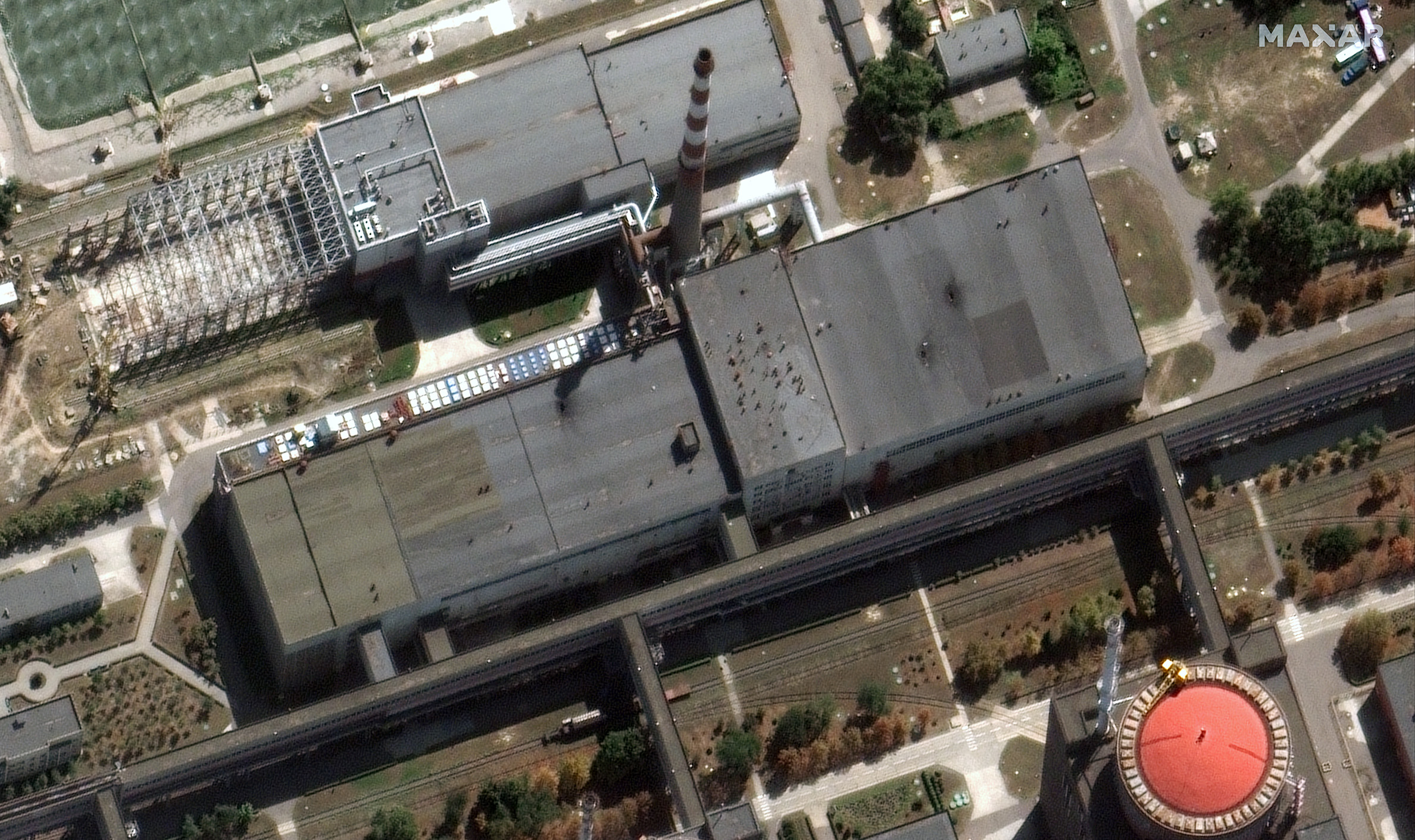
On September 1, a representative of the Russians explained to IAEA director Rafael Grossi that the projectile at the moment of landing allegedly turns 180 degrees around its axis, which is why it sticks out of the ground as if it came from the territory occupied by the Russians.
On the night of September 2-3, the Russians shelled Nikopol from a location close to the ZNPP, as evidenced by a video released by The Insider.
A mine explosion on the perimeter of the ZNPP. On September 29, an explosion occurred on the voltage supply line to the nitrogen-oxygen station from power unit # 6. The reason is that the perimeter of the ZNPP was mined by the Russian military," reports Energoatom. "There have already been six cases when dogs, foxes, and wild boars blew themselves up on mines."
On September 30, the Russians abducted the general director of the ZANP, Ihor Murashov, and took him to the "Yama" torture chamber (according to The Wall Street Journal). He was released from captivity on October 3 thanks to widespread publicity and the intervention of the Director General of the IAEA.
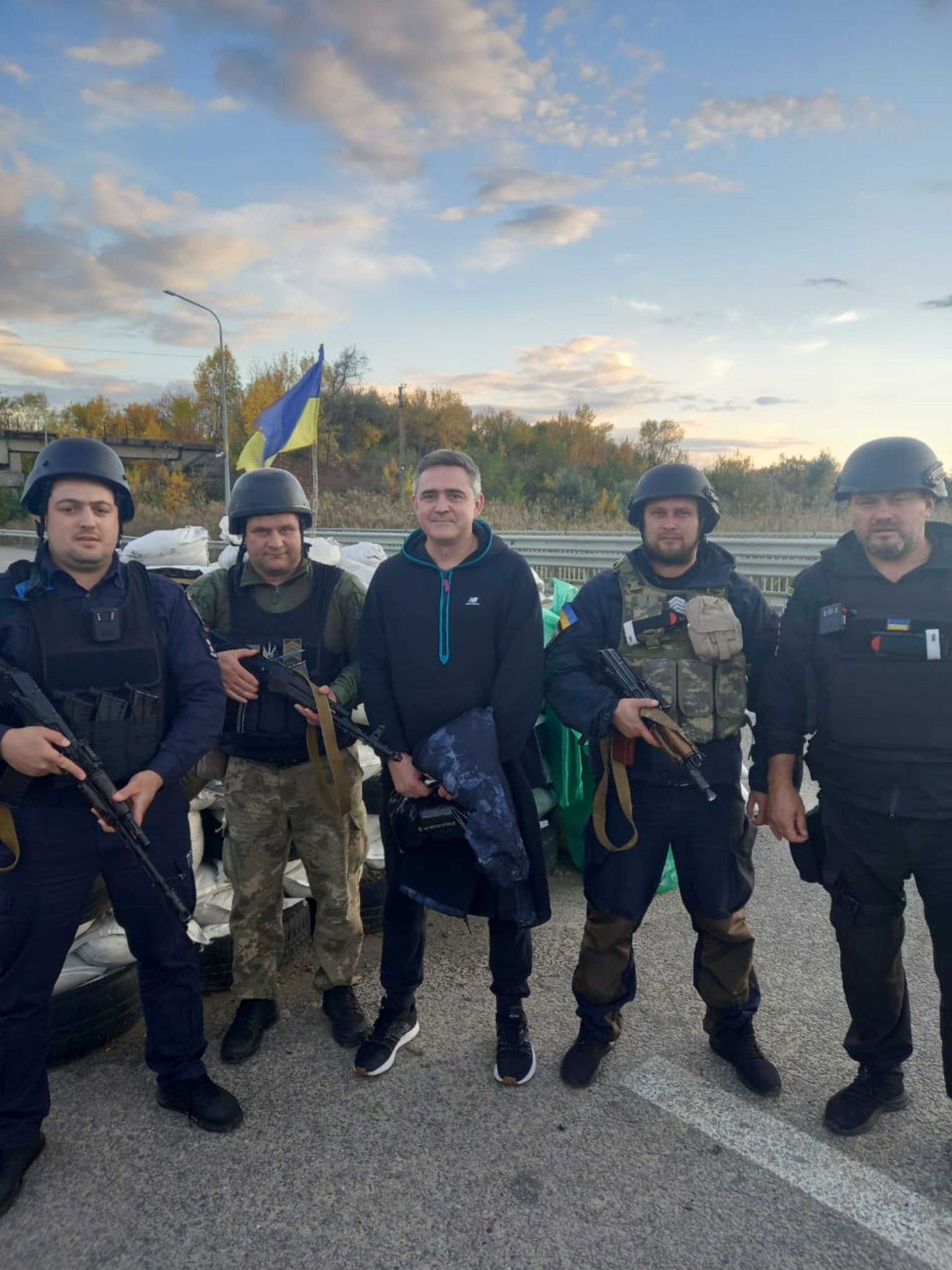
On October 26, it became known that the fish, which performed a sanitary function and ensured the cleanliness of the cooling tubes of the turbine condenser, died of hypothermia in the cooling pool. Warm water does not enter the cooling pond due to the shutdown of the ZNPP.
On November 2, the ZNPP was de-energized due to shelling of high-voltage communication lines with the Ukrainian power system, and diesel generators started working. Power units # 5 and # 6 have been transferred to a cold state.
On December 7, Energoatom announced that the Russians had placed several Grad rocket launchers at the power unit # 6, near the site of the station's dry spent nuclear fuel storage facility, where some "defensive structures" had previously been secretly built.
"Testing and commissioning of mobile diesel boilers is ongoing at the station to prevent freezing of critical systems of the ZNPP in the winter," the IAEA report for December 13 states. Mobile diesel boilers with a capacity of 1-3 MW are installed and working at one of the power units, several more are located in other places on the site.
Shelling of Nikopol from Enerhodar
From mid-March 2022, the Russian army began shelling populated areas on the opposite bank of the Dnipro River from the station, using the territory of the ZNPP as a shield. Experts of the Conflict Intelligence Team confirmed that the missile attack was carried out from the area near the ZNPP.
The range of Russian weapons located near the Dnipro

Shelling of the ZNPP
When the Russian army seized the nuclear power plant, it violated international agreements not to use nuclear facilities for military purposes.
Now Russia accuses Ukraine of shelling the ZNPP, but does not provide irrefutable evidence, categorically refuses to demilitarize the station and create a security zone around the ZNPP.

September 1, 2022. The Russian representative convinces the director general of the IAEA that the fragment of the projectile, which is sticking out on the territory of the ZNPP near the storage of spent nuclear fuel, was fired by the Ukrainian army, but when it landed it turned 180 degrees and that is why it looks as if it came from the territory occupied by the Russian army.
Screenshot from the video released by Andrii Tsaplienko.
Satellite images indicate the growth of combat positions around the ZNPP during the summer-autumn of 2022. Employees of the station, who stayed to work there or left after it was captured by the Russians, anonymously talk about the placement of Russian firing positions, military equipment, soldiers and ammunition on the territory of the ZNPP. TEXTY's source claims that the Russians, who have occupied almost all premises on the territory of the station, are constantly moving and disguising their equipment
Regular shelling of the ZNPP began on August 5, 2022. They were aimed at destroying the high-voltage lines that connected the ZNPP with the Ukrainian system, but also to create an "image" for Russian propaganda about the alleged Ukrainian shelling. Station employees say that the Russians previously found out in detail how the station works and what is located where. This is so they can hit without shelling causing any real damage to the station – except for the destruction of the power grids mentioned above.
One may wonder why not simply dismantle these networks, since they go through the Russia-occupied territory? For Russians, they are important as a propaganda factor, the nature of which observers from distant capitals might struggle to grasp. Any danger resulting from shelling becomes a good excuse to assign the blame on Ukraine.
By August 8, only one of the three such lines survived the shelling – "Dniprovska", laid across the Kakhovka reservoir.
Switching ZNPP to Crimea
They are provoking a "blackout" at the station in order to "save" the NPP from a large-scale accident by connecting it to the Russian power system.
"During August alone, the third power unit was shut down three times and restarted three times – without inspections, without any attempt to find out the reasons for the shutdowns and conclusions, as required by the regulations," says Olha Kosharna, a former Board member of the State Inspection of Nuclear Regulation of Ukraine. Emergency shutdowns after shelling of power lines continued throughout the fall.
Back in May, Russian Deputy Prime Minister Marat Khusnullin spoke about the plans to "integrate" not only the ZNPP, but also the Kakhovka HPP and all solar and wind generation in the occupied territories during a visit to then-occupied Kherson. He also mentioned the restoration of the only main high-voltage line that was blown up in 2015, running through Dzhankoy and through the ZNPP, which could supply electricity to the occupied Crimea.
The ZNPP is connected to the Ukrainian power grid through four 750 kV high-voltage transmission lines. Before the shelling began, two high-voltage lines were in use: "ZNPP – Dnipro" line, which goes through the Kakhovka reservoir in the direction of Nikopol, and "Kakhovska" line, which leads to the "Kakhovska" substation. This line is a long-term construction and was only completed at the end of 2020 to receive more power from the NPP. Prior to this substation being built, the ZNPP could not operate at full capacity because there were not enough 750 kV transmission lines to receive the entire amount of electricity from six power units operating at the ZNPP simultaneously.
Map of the power grid around the ZNPP

Attacks on power lines are critically dangerous
Electricity is necessary to maintain a nuclear power plant in a safe condition, because heat resulting from a nuclear reaction should be constantly removed even from switched-off power units. Otherwise, the equipment inside will begin to melt, which can technically cause a hydrogen explosion, of the same nature as the notorious Fukushima accident. Therefore, shelling of power lines can cause a nuclear disaster. The nuclear power plant has diesel generators that automatically turn on when the power supply stops, but this is the last line of defense against disaster. Its frequent use means increased risks.
"After the Fukushima accident, Ukraine conducted stress tests of all nuclear power plants and took into account its lessons based on the EU methodology," comments Olha Kosharna. “They predicted the possibility of flooding and earthquakes affecting the ZNPP. The hermetic shell was strengthened, additional filters were installed to trap radionuclides, and chemical hydrogen recombinators were added under the hermetic shell in case the concentration of hydrogen increases.
Usually, the level of safety is calculated in case of a light plane crash, earthquake, flood, hurricane, tornado. The shelling is not described in security reports as a potentially threatening event.
What areas will be contaminated if an accident occurs at the nuclear power plant? Roughly speaking, if it occurs in the summer, the nuclear contaminants will "fly" to the south of Ukraine, then to Bulgaria, Romania, the Black Sea and Turkey. In the autumn, the winds blow mainly from the west – therefore, the contamination would have reached the Donetsk region and the Krasnodar region in Russia. If the wind is from the south-west, the contamination would affect the free Ukraine, Belarus and Russia."
The mission of the IAEA
In its 57-page report, the IAEA admitted that as a result of the Russian seizure and control of the nuclear power plant, all key principles of nuclear safety were violated. Below is a brief summary:
- The NPP building was damaged in various places.
- Security systems at auxiliary production facilities were damaged.
- The Russian military restricts personnel access to certain areas of the station and exerts constant psychological pressure.
- ZNPP does not maintain stable communication, as required by the standards, with the industry regulator "Energoatom" and the IAEA itself.
- Due to logistical problems, ZNPP does not have a stable supply of diesel fuel for backup generators.

The Russians show the IAEA representatives a shell hole in the roof of the Special Building #1, claiming that it is the result of shelling of the nuclear power plant by the Ukrainian armed forces.
Photo: IAEA
On September 1, during a short visit to the ZNPP, the IAEA mission led by Director General Rafael Grossi was everywhere accompanied by occupiers who spread disinformation about the shelling of the plant. They also organized "letters from concerned citizens" who complained to the inspectors about the shelling by the Armed Forces of Ukraine. Two IAEA employees remain at the station after Rafael Grossi's departure. At the same time, the head of the IAEA is making diplomatic efforts to create a demilitarized zone at the ZNPP and around the station.
Stealing technologies
"The Russians are interested in a safe and working nuclear plant," Olha Kosharna (the correct name is Olha, not Olena) explains the logic of the occupiers' actions, "in order to supply electricity to Crimea, where there is currently a power shortage."
After all, the Crimean thermal power plants with "scandalous" Siemens turbines, launched in 2018, worked on gas coming from the fields where the "Boyko towers" were located – and the Armed Forces destroyed them back in June 2022.
The occupiers would like to transfer the rest of the plant's power to the power system of the Russian Federation to supply the Krasnodar region. ZNPP is also valuable for Russians because it uses Westinghouse fuel (from the US), which is more efficient than Russian fuel.
Station workers are wary that the Russians may have taken fresh as well as used Westinghouse fuel assemblies to Russia to disassemble and carry on studies of the design features.
On the site near the ZNPP there is a dry storage facility for spent fuel, built according to American technology, and a physical protection system, which the United States has supplied since 2014. These are modern technologies that the Russians do not have and that may be of interest to them.
This is another reason why the occupiers terrorize the station's Ukrainian staff and use threats and torture to force them to work for Rosatom — they cannot be replaced by Russians.
The project was jointly prepared by Serhiy Sydorov, Marharyta Ogneva, Veronika Khorolska, Kateryna Rozhdestvenska, Nadia Kelm, Yevheniia Drozdova, Denys Hubashov, Inna Hadzynska.
The material was prepared with the assistance of the Media Development Fund of the US Embassy. The grantor is not responsible for the opinions and information presented in the article.

